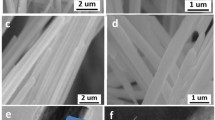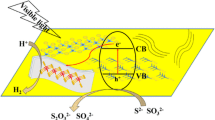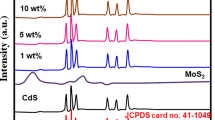Abstract
As a promising and low-cost semiconductor photocatalyst, CdS can be excited under visible-light-driven and it has attracted extensive attention. In order to effectively avoid CdS photocorrosion, MoSe2/CdS composite is fabricated by mean of a special method. The MoSe2/CdS composite exhibits high photo-catalytic activity and stability, when the loading of MoSe2 is 5%, the H2-evolution yield of MoSe2/CdS composite photocatalyst reach 112.4 μmol h−1 under visible light irradiation, which is 4.94 times of pure CdS. In addition, the more detailed studies show that the improvement of photocatalytic activity and stability is due to the following reasons: it can be clearly found from the results of the UV–Visible diffuse reflectance spectrum that MoSe2 in MoSe2/CdS composite greatly improves the light absorption performance,which effectively increases the light absorption intensity of the MoSe2/CdS composite photocatalyst in the photocatalytic reaction system and promotes the electronic transition of the MoSe2/CdS composite photocatalyst. In addition, due to the excellent electron-transfer ability of MoSe2, the rapid transfer of photo-generated charges is further promoted, and the recombination of electron–hole pairs is effectively reduced, thereby MoSe2/CdS catalysts can provide more active sites for hydrogen evolution reaction. Moreover, the MoSe2/CdS composite photocatalyst shows higher photocurrent response, lower overpotential, faster electron transfer rate constant (KET) (3.33 × 108 s−1) and shorter fluorescence lifetime (2.52 ns) than pure CdS and pure MoSe2 because of the effective interface-electron transfer. The MoSe2/CdS composite photocatalyst effectively hinder the photoetching of CdS and achieves high photo-catalytic stability. And the possible mechanism of H2-evolution for MoSe2/CdS is proposed.









Similar content being viewed by others
References
Hao XQ, Jin ZL, Wang F et al (2015) Behavior of borate complex anion on the stabilities and the hydrogen evolutions of ZnxCo3-xO4 decorated graphene. Superlattices Microstruct 82:599–611
Li Q, Guo B, Yu J et al (2011) Highly efficient visible-light-driven photocatalytic hydrogen production of CdS-cluster-decorated graphene nanosheets. J Am Chem Soc 133(28):10878–10884
Bai S, Yang L, Wang C et al (2016) Boosting photocatalytic water splitting: interfacial charge polarization in atomically controlled core-shell cocatalysts. Angew Chem Int Ed 54(49):14810–14814
Yang J, Wang D, Han H et al (2013) Roles of cocatalysts in photocatalysis and photoelectrocatalysis. Acc Chem Res 46(8):1900–1909
Li Y, Zhang H, Liu P et al (2013) Cross-linked g-C3N4/rGO nanocomposites with tunable band structure and enhanced visible light photocatalytic activity. Small 9(19):3336–3344
Deng Y, Zhou Y, Yao Y et al (2013) Facile synthesis of nanosized nickel phosphides with controllable phase and morphology. New J Chem 37(12):4083–4088
Wang W, An T, Li G et al (2017) Earth-abundant Ni2P/g-C3N4, lamellar nanohydrids for enhanced photocatalytic hydrogen evolution and bacterial inactivation under visible light irradiation. Appl Catal B 217:570–580
Ge L, Zuo F, Liu J et al (2012) Synthesis and efficient visible light photocatalytic hydrogen evolution of polymeric g-C3N4 coupled with CdS quantum dots. J Phys Chem C 116(25):13708–13714
Zhao H, Sun S, Jiang P et al (2017) Graphitic C3N4, modified by Ni2P cocatalyst: an efficient, robust and low cost photocatalyst for visible-light-driven H2, evolution from water. Chem Eng J 315:296–303
Hu T, Li P, Zhang J et al (2018) Highly efficient direct Z-scheme WO3/CdS-diethylenetriamine photocatalyst and its enhanced photocatalytic H2, evolution under visible light irradiation. Appl Surf Sci 442:20–29
Jia L, Wang DH, Huang YX et al (2011) Highly durable N-doped graphene/CdS nanocomposites with enhanced photocatalytic hydrogen evolution from water under visible light irradiation. J Phys Chem C 115(23):11466–11473
Rajeshwar K, Tacconi NRD, Chenthamarakshan CR (2001) ChemInform abstract: semiconductor-based composite materials: preparation, properties, and performance. Cheminform 32(48):2765–2782
Simon T, Bouchonville N, Berr MJ et al (2014) Redox shuttle mechanism enhances photocatalytic H2 generation on Ni-decorated CdS nanorods. Nat Mater 13(11):1013–1018
Bao N, Shen L, Takata T et al (2008) Self-templated synthesis of nanoporous cds nanostructures for highly efficient photocatalytic hydrogen production under visible light. Cheminform 39(20):110–117
Zong X, Yan H, Wu G et al (2008) Enhancement of photocatalytic H2 evolution on CdS by loading MoS2 as Cocatalyst under visible light irradiation. J Am Chem Soc 130(23):7176
Chang K, Li M, Wang T et al (2015) Drastic layer-number-dependent activity enhancement in photocatalytic H2 evolution over nMoS2/CdS (n ≥ 1) under visible light. Adv Energy Mater 5(10):1402279
Yang J, Wang D, Han H et al (2013) Roles of cocatalysts in photocatalysis and photoelectrocatalysis. Acc Chem Res 46(8):1900–1909
Zong X, Wu G, Yan H et al (2010) Photocatalytic H2 evolution on MoS2/CdS catalysts under visible light irradiation. J Phys Chem C 114(4):1963–1968
Li SS, Wang L, Liu S et al (2018) In situ synthesis of strongly coupled Co2P-CdS nanohybrids: an effective strategy to regulate photocatalytic hydrogen evolution activity. ACS Sustain Chem Eng 6(8):9940–9950
Qiu-XiaPeng DanXue, Shu-ZhongZhan Chun-LinNi (2017) Visible-light-driven photocatalytic system based on a nickel complex over CdS materials for hydrogen production from water. Appl Catal B 219:353–361
Kumar DP, Song MI, Hong S et al (2017) Optimization of active sites of MoS2 nanosheets using nonmetal doping and exfoliation into few layers on CdS nanorods for enhanced photocatalytic hydrogen production[J]. Acs Sustain Chem 5(9):7651–7658
Shi X, Fujitsuka M, Kim S et al (2018) Faster electron injection and more active sites for efficient photocatalytic H2 evolution in g-C3N4/MoS2 hybrid. Small 14(11):e1703277
Bian H, Ji Y, Yan J et al (2018) In situ synthesis of few-layered g-C3N4 with vertically aligned MoS2 loading for boosting solar-to-hydrogen generation. Small 14(3):1703003
Zhao Z, Qin F, Kasiraju S et al (2017) Vertically aligned MoS2/Mo2C hybrid nanosheets grown on carbon paper for efficient electrocatalytic hydrogen evolution. Acs Catal 7(10):7312–7318
Vikraman D, Hussain S, Akbar K et al (2018) Improved hydrogen evolution reaction performance using MoS–WS2 heterostructures by physicochemical process. Acs Sustain Chem Eng 6(7):8400–8409
Zeng D, Wu P, Ong WJ et al (2018) Construction of network-like and flower-like 2H-MoSe2 nanostructures coupled with porous g-C3N4, for noble-metal-free photocatalytic H2 evolution under visible light. Appl Catal B 233:26–34
Feng C, Chen Z, Hou J et al (2018) Effectively enhanced photocatalytic hydrogen production performance of one-pot synthesized MoS2, clusters/CdS nanorod heterojunction material under visible light. Chem Eng J 345:404–413
Zhang S, Yin X, Zheng Y (2018) Enhanced photocatalytic reduction of CO2, to methanol by ZnO nanoparticles deposited on ZnSe nanosheet. Chem Phys Lett 693:170–175
Wei RB, Huang ZL, Gu GH et al (2018) Dual-cocatalysts decorated rimous CdS spheres advancing highly-efficient visible-light photocatalytic hydrogen production. Appl Catal B 231:101–107
Silva LA, Su YR, Choi J et al (2008) Photocatalytic hydrogen production with visible light over pt-interlinked hybrid composites of cubic-phase and hexagonal-phase CdS. J Phys Chem C 112(32):12069–12073
Hou JH, Lei YG, Wang F et al (2017) In-situ photochemical fabrication of transition metal-promoted amorphous molybdenum sulfide catalysts for enhanced photosensitized hydrogen evolution. Int J Hydrog Energy 42(16):11118–11129
Chu J, Han X, Yu Z et al (2018) Highly efficient visible-light-driven photocatalytic hydrogen production on CdS/Cu7S4/g-C3N4 ternary heterostructures. ACS Appl Mater Interfaces 10(24):20404–20411
Lei Y, Hou J, Wang F et al (2017) Boosting the catalytic performance of MoSx cocatalysts over CdS nanoparticles for photocatalytic H2 evolution by Co doping via a facile photochemical route. Appl Surf Sci 420:456–464
Yang H, Jin ZL, Wang GR et al (2018) Light-assisted synthesis MoSx as a noble metal free cocatalyst formed heterojunction CdS/Co3O4 photocatalyst for visible light harvesting and spatial charge separation. Dalton Trans 47:6973–6985
Hu S, Jiang QQ, Ding SP et al (2018) Construction of hierarchical MoSe2 hollow structures and its effect on electrochemical energy storage and conversion. ACS Appl Mater Interfaces 10(30):25483–25492
Wang PF, Zhan SH, Wang H et al (2018) Cobalt phosphide nanowires as efficient Co-catalyst for photocatalytic hydrogen evolution over Zn0.5Cd0.5S. Appl Catal B Environ 230:210–219
Yang CW, Qin JQ, Xue Z et al (2017) Rational design of carbon-doped TiO2 modified g-C3N4 via in situ heat treatment for drastically improved photocatalytic hydrogen with excellent photostability. Nano Energy 41:1–9
Wang D, Zhang X, Bao S et al (2017) Phase-engineering of multiphasic 1T/2H MoS2 catalyst for highly efficient hydrogen evolution. J Mater Chem A 5:2681–2688
Gopannagari M, Kumar DP, Park H et al (2018) Influence of surface-functionalized multi-walled carbon nanotubes on CdS nanohybrids for effective photocatalytic hydrogen production. Appl Catal B 236:294–303
Kumar DP, Hong S, Reddy DA et al (2017) Ultrathin MoS2 layers anchored exfoliated reduced graphene oxide nanosheet hybrid as a highly efficient cocatalyst for CdS nanorods towards enhanced photocatalytic hydrogen production. Appl Catal B Environ 212:7–14
Tahir MB, Nabi G, Iqbal T et al (2018) Role of MoSe2 on nanostructures WO3-CNT performance for photocatalytic hydrogen evolution. Ceram Int 44:6686–6690
Wang Y, Zhao JX, Chen Z et al (2019) Construction of Z-scheme MoSe2/CdSe hollow nanostructure with enhanced full spectrum photocatalytic activity. Appl Catal B 244:76–86
Kumar DP, Kim EH, Park H et al (2018) Tuning band alignments and charge transport properties through MoSe2 bridging between MoS2 and CdS for enhanced hydrogen production. ACS Appl Mater Interfaces 10:26153–26161
Yi JJ, Li HP, Gong YJ et al (2019) Phase and interlayer effect of transition metal dichalcogenide cocatalyst toward photocatalytic hydrogen evolution: the case of MoSe2. Appl Catal B 243:330–336
Chen R, Wang PF, Chen J et al (2019) Synergetic effect of MoS2 and MXene on the enhanced H2 evolution performance of CdS under visible light irradiation. Appl Surf Sci 473:11–19
Zhou XZ, Huang JJ, Zhang HZ et al (2016) Controlled synthesis of CdS nanoparticles and their surface loading with MoS2 for hydrogen evolution under visible light. Int J Hydrog Energy 41:14758–14767
Han B, Liu S, Zhang N et al (2017) One-dimensional CdS@MoS2 core-shell nanowires for boosted photocatalytic hydrogen evolution under visible light. Appl Catal B 202:298–304
Yang MQ, Han C, Xu YJ (2015) Insight into the effect of highly dispersed MoS2 versus layer-structured MoS2 on the photocorrosion and photoactivity of CdS in graphene–CdS–MoS2 composites. J Phys Chem C 119:27234–27246
Li Y, Wang H, Peng S (2014) Tunable photodeposition of MoS2 onto a composite of reduced graphene oxide and CdS for synergic photocatalytic hydrogen generation. J Phys Chem C 118:19842–19848
Yu X, Du R, Li B et al (2016) Biomolecule-assisted self-assembly of CdS/MoS2/graphene hollow spheres as high-efficiency photocatalysts for hydrogen evolution without noble metals. Appl Catal B 182:504–512
Wang GR, Jin ZL (2019) Function of NiSe2 over CdS nanorods for enhancement of photocatalytic hydrogen production—from preparation to mechanism. Appl Surf Sci 467:1239–1248
Lian Z, Sakamoto M, Kobayashi Y et al (2018) Durian-shaped CdS@ZnSe Core@Mesoporous-shell nanoparticles for enhanced and sustainable photocatalytic hydrogen evolution. J Phys Chem Lett 9:2212–2217
Acknowledgements
This work was financially supported by the Chinese National Natural Science Foundation (Grant Nos. 21862002, 41663012, 21263001), the new technology and system for clean energy catalytic production, Major scientific project of North Minzu University (Grant No. ZDZX201803), the Laboratory for the development and application of electrochemical energy conversion technology, North Minzu University and The Ningxia low-grade resource high value utilization and environmental chemical integration technology innovation team project, North Minzu University.
Author information
Authors and Affiliations
Contributions
YL and ZJ conceived and designed the experiments; YL performed the experiments; HW and ZJ contributed reagents/materials and analysis tools; and YL wrote the paper, YL revised Manuscript.
Corresponding authors
Ethics declarations
Conflicts of interest
The authors declare that they have no conflict of interests.
Additional information
Publisher's Note
Springer Nature remains neutral with regard to jurisdictional claims in published maps and institutional affiliations.
Rights and permissions
About this article
Cite this article
Liu, Y., Ma, X., Wang, H. et al. CdS Photocorrosion Protection by MoSe2 Modification for Photocatalytic Hydrogen Production. Catal Surv Asia 23, 231–244 (2019). https://doi.org/10.1007/s10563-019-09275-3
Published:
Issue Date:
DOI: https://doi.org/10.1007/s10563-019-09275-3




